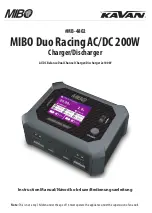
I
NSTRUCTIONS
M
ANUAL
D
IGIT
3001
R
ELEASE
.
N.2_M
13_10_08
P
OWERGEN
S.
R
.
L
.
V
IA
XXV
A
PRILE
,
5
L
OC
.
C
ORSALONE
C
HIUSI DELLA
V
ERNA
(A
REZZO
)
)
+39-(0)575-531015 - T39-(0)575-511891 E mail
www.batterychargerpowergen.it
P.Iva 01572290516
- 18 -
8.6.
Setting of Default Parameters
DIGIT3001 allows to retrieve the setting of default values based on the following
procedure:
- set dip-switch DSW1 to
programming mode
. "
ProG
"
will be shown on the
display.
- press the right-hand “
EQU
” and the left-hand “
ON/OFF
” buttons simultaneously. "
----
"
will be shown on the display.
- keep both buttons pressed for about 5 seconds. At the end "
dEF
"
will be
shown on the display and the default values will be accessed at this point;
- "
ProG
"
will be shown again on the display after about 1 second and the
settings of charging parameters may be manually changed, if needed. Also the
charge may be started by setting the dip-switch to the correct charging position
(
Charge
).
With the present firmware version, the setting of default parameters refers to the
configuration of parameters for a 24V battery with Wa charge; in all the other cases
the User shall reconfigure the charging parameters manually as described in the
programming paragraph.
Monitor and supervision of the correct microprocessor operation via an external
supervising circuit
The supervising circuit is supplied with a watchdog timer to which pulses are periodically
sent by the microprocessor. If no pulses are present, the supervisor will reset the
microprocessor. The periodic transmission of pulses shows the correct operation of the
microprocessor.
Automatic recognition and charging cycle for sulphated batteries
DIGIT3001 is able to automatically recognize whether the battery to be charged is
sulphated or not. In particular, in the first minutes of charge DIGIT3001 keeps battery
voltage and charging current values under control. If the battery voltage exceeds the
threshold voltage and the charging current is lower than the minimum current set in the
programming phase, the control card determines that the battery is sulphated and the
charging cycle will not be allowed to switch to timed cycle. The initial cycle will be
maintained instead. Under these conditions the control will wait for battery voltage to drop
below the threshold voltage and then rise again above such value and when the charging
current exceeds the minimum value, it will allow the changeover to the timed charging
cycle.
As in the ordinary charging cycle, the safety alarms for maximum charging time and
minimum and maximum battery voltage are always active, as well as the current control.









































